New Zealand Defence Force
The New Zealand Defence Force (NZDF; Māori: Te Ope Kātua o Aotearoa, lit. "Line of Defence of New Zealand") consists of three services: the Royal New Zealand Navy, the New Zealand Army and the Royal New Zealand Air Force; and is commanded and headed by the chief of Defence Force (CDF).
| New Zealand Defence Force | |
|---|---|
| Te Ope Kātua o Aotearoa (Māori) | |
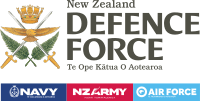 The NZDF Tri-Service logo | |
| Founded | 1909 |
| Service branches | Royal New Zealand Navy New Zealand Army Royal New Zealand Air Force |
| Headquarters | Wellington |
| Website | nzdf |
| Leadership | |
| Commander-in-Chief | Her Excellency The Rt Hon Dame Patsy Reddy (as Governor-General of New Zealand) |
| Minister of Defence | Hon Ron Mark |
| Chief of Defence Force | Air Marshal Kevin Short |
| Manpower | |
| Military age | 17 years of age with parental consent; service members cannot be deployed until 18 (As of September 2017)[1] |
| Available for military service | 955,640 males, age 20-49[2], 981,050 females, age 20-49[3] |
| Active personnel | 11,900 (as of June 2017)[4] |
| Reserve personnel | 2,600 (as of June 2017)[4] |
| Deployed personnel | 302 (as of June 2017)[4] |
| Expenditures | |
| Budget | Total budget for 2019/20[5] Vote Defence Force (NZD) |
| Percent of GDP | 1.1%[6] |
| Industry | |
| Foreign suppliers | |
| Related articles | |
| History | Military history of New Zealand |
| Ranks | New Zealand military ranks |
New Zealand's armed forces have three defence-policy objectives:
- to defend New Zealand against low-level threats
- to contribute to regional security
- to play a part in global security efforts
New Zealand regards its own national defence needs as modest, due to its geographical isolation and friendly relationships with neighbours.[7] As of September 2017 the NZDF had 302 personnel deployed overseas on operations and on UN missions in the South Pacific, Asia, Africa, Antarctica and the Middle East areas.[8]
As at 2018, the governor-general and commander-in-chief,[9] Dame Patsy Reddy, exercises power on the advice of the minister of defence, Ron Mark, under the Defence Act 1990. Mark was appointed minister of defence as a member of the Labour–NZ First government following the 2017 election.
Air Marshal Kevin Short was appointed chief of Defence Force on 1 July 2018.[10][11][12] The NZDF has announced that Air Vice-Marshal Tony Davies will serve as the next vice chief of Defence Force.[13]
History of the armed services
Militia (1845–1886)
After the Treaty of Waitangi in 1840, New Zealand's security was dependent on British Imperial troops deployed from Australia and other parts of the empire. By 1841 the settlers, particularly those in the New Zealand Company settlement of Wellington, were calling for local militia to be formed.[14] In 1843 a local militia had been formed in Wellington without official sanction.[15] This prompted the Chief Police Magistrate Major Matthew Richmond to order its immediate disbandment. Richmond also dispatched 53 soldiers from the 96th Regiment from Auckland to Wellington.
These calls for a militia continued to grow with the Wairau Affray, the start of the New Zealand Wars. The calls eventually lead to a bill being introduced to the Legislative Council in 1844.[16] Those present noted their disapproval of the bill, unanimously deferring it for six months. On 22 March 1845 the Flagstaff War broke out, which proved to be the catalyst for passing the Bill.[17]
In 1844 a Select Committee of the House of Commons had recommended that a militia, composed of both settlers and native Maori, and a permanent native force be set up.[18]
On 25 March 1845, the Militia Ordinance was passed into law.[19] Twenty-six officers were appointed in Auckland, thereby forming the start of New Zealand's own defence force.[20] Major Richmond was appointed the commander of the Wellington Battalion of the militia.[21] The newspaper article of the time notes that Wellington had a mounted Volunteer Corp. The Nelson Battalion of Militia was formed 12 August 1845.[22]
In June 1845, 75 members of the Auckland Militia under Lieutenant Figg became the first unit to support British Imperial troops in the Flagstaff War, serving as pioneers.[23] Seven militia were wounded in action between 30 June and 1 July 1845. One, a man named Rily, later died of his wounds.[24] The Auckland Militia was disbanded in August or early September 1845 because of budgetary constraints.[25] Disbandment of the Nelson and Wellington Militias followed much to the dismay of their supporters.[26] Those at Nelson under Captain Greenwood decided, regardless of pay or not, to continue training.[27]
Trouble in the Hutt Valley, near Wellington, in early March 1846 prompted the new Governor George Grey to proclaim martial law and call out the Hutt Militia, in what became known as the Hutt Valley Campaign.[28] Following on from this the local paper noted that the No 1 Company of the Wellington Militia had been called out, while the troops stationed in the town had been in the Hutt.[29] The paper further noted that Grey intended to maintain two companies of Militia in Wellington. As problems continued in the area at least 160 Militia remained.[30] These were supplemented by volunteers and Māori warriors from the Te Aro pah.[31]
On 28 October 1846, with the passing of the Armed Constabulary Ordinance in 1846, a fresh call was made by Mr Donnelly of the Legislature to do away with the Militia because of its expense.[32] However the cost to Britain of maintaining a military force in New Zealand was considerable, prompting a dispatch on 24 November 1846 from The Right Hon Earl Grey to advise Lieutenant Governor George Grey that
... the formation of a well-organised Militia and of a force of Natives in the service of Her Majesty, would appear to be the measures most likely to be successfully adopted.[33]
Further pressure in the early 1850s from Britain for removing their forces prompted pleas for them to remain as the Militia were deemed insufficient for the purpose.[34]
1854 brought a new threat to the attention of the colony because up to that time the military focus had been upon internal conflicts between settlers and the Māori. War had broken out between Russia and Turkey. This war began to involve the major European powers and exposed New Zealand and Australia to a possible external threat from the Imperial Russian Navy.[35] Parliament discussed providing guns at ports around the country for use in the event of a war with a foreign power.[36]
By 1858 attention had swung back to local issues with a land dispute in New Plymouth prompting Governor Thomas Gore Browne to call out its militia under Captain Charles Brown.[37] A prelude to what was to become the First Taranaki War and a period of conflict in the North Island until 1872.
The newly-formed New Zealand Parliament revised and expanded the Militia Ordinance, replacing it with the Militia Act 1858.[38] Some of the main changes were clauses enabling volunteers to be included under such terms and conditions as the Governor may specify. The act also outlined the purposes under which Militia could be called upon, including invasion. Debates in Parliament had included expressions of concern about Russian naval expansion in the northern Pacific, pointed out that the sole naval defence consisted of one 24-gun frigate, and the time it would take for Britain to come to the colony's aid.
British Imperial troops remained in New Zealand until February 1870, during the later stage of the New Zealand Wars, by which time settler units had replaced them.[39]
The Defence Act 1886 reclassified the militia as volunteers. These were the forerunners of the Territorials.
Volunteers (1858–1909)
Although there were informal volunteer units as early as 1845, the appropriate approval and regulation of the units did not occur until the Militia Act 1858. Those who signed up for these units were exempt from militia duty, but had to be prepared to serve anywhere in New Zealand. One of the earliest gazetted units (13 January 1859) was the Taranaki Volunteer Rifle Company.[40]
To the Volunteer Rifle Corps were added Volunteer Artillery Corps in mid-1859. The first of these Volunteer Artillery Corps were based in Auckland.[41]
By late 1859 the number of volunteer units was so great that Captain H C Balneavis was appointed Deputy Adjunct-General, based at Auckland.[42]
Colonial Defence Force (1862–1867)
In 1863 the government passed the Colonial Defence Force Act 1862 creating the first Regular Force. This was to be a mounted body of not more than 500 troops, with both Maori and settlers, and costing no more than 30,000 pounds per annum.[43] All were volunteers and expected to serve for three years.
Formation of the first unit did not begin until early April 1863, with 100 men being sought at New Plymouth under Captain Atkinson.[44] Hawke's Bay was to have the next unit.[45] By late April, papers were reporting few had enlisted in New Plymouth.[46]
Formation of an Auckland unit under Colonel Nixon commenced in July and by the 14th had 30 men.[47]
Authorised units by July 1863
Commander: Major-General Galloway[48][49][50]
| Location | Authorised | Actual | Commander |
|---|---|---|---|
| Auckland | 100 | 50 | Lieutenant Colonel Marmaduke George Nixon |
| Ahuriri (Hawke's Bay)[51] | 100 | 100 | Major George Stoddart Whitmore[52] |
| New Plymouth | 100 | - | Captain Harry Albert Atkinson |
| Otago[53] | 50 | Mr Branigan | |
| Wairarapa | 50 | ||
| Wellington | 100 | James Townsend Edwards[54] |
By October 1863 there was no Wairarapa-based defence force, and 50 were based in Wanganui.[55] The Otago force had earlier been moved to Wellington, with further Otago volunteers heading for the Auckland and Hawke's Bay Units. The total Defence Force numbered 375 by 3 November 1863.[56]
In October 1864 the Government decided to reduce the numbers in the Colonial Defence Force to 75 with three units of 25 members each in Wellington, Hawkes Bay and Taranaki.[57] By this time there were about 10,000 British Imperial troops in New Zealand, supplemented by about as many New Zealand volunteer and militia forces. There were calls, particularly from South Island papers, for the British Imperial troops to be replaced by local forces.[58] Parliamentary debates in late 1864 also supported this view, especially as the cost of maintaining the Imperial troops was becoming a greater financial burden on the colony.[59]
Defence review, March 1865
At the request of the governor in January 1865 a formal statement on the defence of the colony was presented on 20 March 1865. This proposed an armed constabulary force supported by friendly natives, volunteer units, and militia as the case may require be established to take the place of the Imperial troops.[60] The proposed force was to consist of 1,350 Europeans and 150 Maori – 1,500 in total. They were to be divided into 30 companies of 50 men each based as follows:
| Province | Location | Number |
|---|---|---|
| Auckland | Queens Redoubt south, between the Waikato and Waipa Rivers | 6 |
| From the Bluff to Pukorokoro | 3 | |
| In reserve at Papakura or vicinity | 3 | |
| Tauranga | 1 | |
| Taranaki and Wellington | Taranaki and Wanganui Districts | 12 |
| Wellington | 1 | |
| Hawke's Bay | Napier | 4 |
The total Defence budget, which included purchasing a steamer for use on the Waikato, Patea, and Wanganui rivers, was 187,000 pounds per annum. The budget's focus was solely on internal conflict. The issue of external conflict did not begin to resurface until the following year, with thought being given again to coastal defences.[61]
The Colonial Defence Force was disbanded in October 1867 by the Armed Constabulary Act 1867. Its members transferred to the Armed Constabulary.
Evolution of volunteers and militia
From 1863 to 1867 Forest Ranger volunteer units were formed, tasked with searching out Maori war parties, acting as scouts, and protecting lines of communication. They arose out of the need to prevent ambushes and random attacks on civilians near forest areas.[62] The Rangers were well armed and more highly paid. These units used guerrilla style tactics, moving through areas under cover of darkness and ambushing war parties. The Forest Rangers were disbanded on 1 October 1867.[63]
Alongside the militia and the British Imperial forces were the Armed Constabulary. The Armed Constabulary were formed in 1846 with the passage of the Armed Constabulary Ordinance.[64] The Constabulary's role was both regular law enforcement and during the New Zealand Wars militia support. From 1867 to 1886 the Armed Constabulary were the only permanent force in New Zealand. In 1886 the militia functions of the Armed Constabulary were transferred to the New Zealand Permanent Militia by the Defence Act 1886. Lieutenant Colonel John Roberts was the Permanent Militia's first commander from January 1887 to his retirement in 1888.[65]

Defence Act 1909
The Defence Act 1909 replaced the Volunteer forces with a Territorial force and compulsory military training, a regime that remained until the late 1960s, with breaks from 1918 to 1921, 1930 to 194?, and 194? to 1948.[66]
Separate services (from 1909)
.jpg)
Independent New Zealand armed forces developed in the early twentieth century; the Royal New Zealand Navy was the last to emerge as an independent service in 1941.[67] Prior to that time it had been the New Zealand Division of the Royal Navy. New Zealand forces served alongside the British and other Empire and Commonwealth nations in World War I and World War II.
The fall of Singapore in 1942 showed that Britain could no longer protect its far-flung Dominions. Closer military ties were therefore necessary for New Zealand's defence. With United States entering the war, they were an obvious choice. Links with Australia had also been developed earlier; both nations sent troops to the Anglo-Boer War and New Zealand officer candidates had trained at Australia's Royal Military College, Duntroon since 1911, a practice that continues to this day. A combined Australian and New Zealand Army Corps (ANZAC) was formed for the Gallipoli Campaign during World War I, and its exploits are key events in the military history of both countries.
The NZDF came into existence under the Defence Act 1990. Under previous legislation, the three services were part of the Ministry of Defence. Post-1990, the Ministry of Defence is a separate, policy-making body under a Secretary of Defence, equal in status to the Chief of Defence Force.
For the first time, two of the Deputy Chiefs of service, Navy and Air Force, one-star Commodores and Air Commodores, are women. Captain Melissa Ross was promoted to Commodore and appointed as Deputy Chief of Navy in December 2019,[68] while in August 2019 Group Captain Carol Abraham was promoted to Air Commodore and appointed as Deputy Chief of Air Force.[69] Another female officer, Colonel Helen Cooper, had previously held the post of Deputy Chief of Army though in an acting capacity without being promoted to the customary rank of Brigadier. In an unusual move, as of February 2020, the Deputy Chief of Army, Evan Williams, holds not just the customary rank of Brigadier but that of Major General, usually only held by the Chief of Army.[70]
Higher direction of the armed services
A new HQNZDF facility was opened by Prime Minister Helen Clark in March 2007.[71] The new facility on Aitken St in the Wellington CBD replaced the premises on Stout St that had been the headquarters of NZDF for nearly 75 years. The Aitken St facility initially was home to around 900 employees of the NZDF, the New Zealand Security Intelligence Service (NZSIS) and the New Zealand Ministry of Defence; the NZSIS moved across to Pipitea House in early 2013,[72] and the NZDF were forced to vacate the Aitken St building after the 2016 Kaikoura earthquake, which seriously damaged the building.[73] As of October 2017 it is undergoing demolition, with this scheduled to be completed in early 2018;[74] HQNZDF functions having been moved into other buildings and facilities across the region. HQNZDF operates as the administrative and support headquarters for the New Zealand Defence Force, with operational forces under the separate administrative command and control of HQJFNZ.
Joint Forces headquarters
The operational forces of the three services are directed from Headquarters Joint Forces New Zealand opposite Trentham Military Camp in Upper Hutt. HQ JFNZ was established at Trentham on 1 July 2001. From this building, a former NZ government computer centre that used to house the Army's Land Command, the Air Component Commander, Maritime Component Commander, and Land Component Commander exercise command over their forces. Commander Joint Forces New Zealand (COMJFNZ), controls all overseas operational deployments and most overseas exercises.[75]
Senior officers
As of 2019:
| Chief of Defence Force Air Marshal Kevin Short | |||||||
| Vice Chief of Defence Force Air Vice Marshal Tony Davies |
Commander Joint Forces New Zealand Rear Admiral James Gilmour |
Chief of Navy Rear Admiral David Proctor |
 Chief of Army Major General John Boswell |
Chief of Air Force Air Vice Marshal Andrew Clark | |||
| Special Operations Component Commander Unnamed NZSAS Colonel[76] |
Maritime Component Commander Commodore Tony Millar |
Land Component Commander Brigadier Jim Bliss[77] |
Air Component Commander Air Commodore Tim Walshe |
Deputy Chief of Navy Commodore Melissa Ross |
Deputy Chief of Army Brigadier Evan Williams |
Deputy Chief of Air Force Air Commodore Carol Abraham | |
The Defence Force created a joint-service corporate services organisation known as the Joint Logistics and Support Organisation (JLSO) in the 2000s, which later became Defence Shared Services.
Following the establishment of Special Operations Command on 1 July 2015, the new position of Special Operations Component Commander was created. This officer reports to the Commander Joint Forces New Zealand, and is of equivalent status to the Maritime, Land and Air Component Commanders.[78]
Support for servicemen and women
In recent years, the New Zealand Defence Force has implemented a policy of honoring veterans, and increased its support to still servicemen and women in a number of ways.[79] This includes starting the Defence Force KiwiSaver Scheme, and appointing financial advisers[80] to support the welfare of members.[81]
Branches
Navy
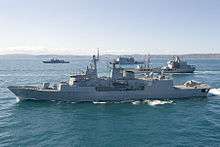
The Royal New Zealand Navy (RNZN) has 2,132 full-time and 435[82] part-time sailors. The RNZN possess two Anzac class frigates, developed in conjunction with Australia, based on the German MEKO 200 design. Nine other vessels are in use, consisting of patrol vessels and logistics vessels. In 2010, the RNZN completed the acquisition of seven new vessels: one large Multi-Role Vessel named HMNZS Canterbury, two Offshore Patrol Vessels, and two Inshore Patrol Vessels. All of these vessels were acquired under Project Protector, and were built to commercial, not naval, standards.
Army
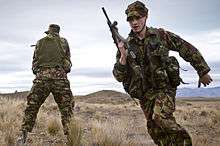
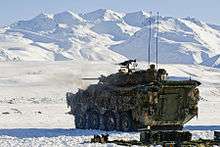
New Zealand's Army has 4,584 full-time and 1,671 part-time troops.[82] They are organised as light infantry and motorised infantry equipped with 102 Canadian-manufactured LAV III Light Armoured Vehicles (NZLAV). There are also armoured reconnaissance, artillery, logistic, communications, medical and intelligence elements. The New Zealand Special Air Service is the NZDF's special forces capability, which operates in both conventional warfare and counter-terrorist roles. The Corps and Regiments of the New Zealand Army include:
- Royal New Zealand Infantry Regiment
- Royal New Zealand Armoured Corps
- Royal Regiment of New Zealand Artillery
- Corps of Royal New Zealand Engineers
- Royal New Zealand Corps of Signals
- Royal New Zealand Army Logistic Regiment
- Royal New Zealand Army Medical Corps
- Royal New Zealand Army Nursing Corps
- Royal New Zealand Army Dental Corps
- Corps of Royal New Zealand Military Police
- New Zealand Intelligence Corps
- New Zealand Army Legal Services
Air Force

The Royal New Zealand Air Force (RNZAF) has 2,403 full-time and 212 part-time airmen and airwomen.[82] The RNZAF consists of 51 aircraft, consisting of P-3 Orion maritime patrol aircraft and Lockheed C-130 Hercules and other transport aircraft. The NHIndustries NH90 operates in a medium-utility role, and the AgustaWestland A109 operates the light utility helicopter role, in addition to the main training platform. RNZAF primary flight training occurs in Beechcraft T-6 Texan IIs, before moving onto the Beechcraft King Air.
The RNZAF does not have air combat capabilities following the retirement without replacement of its Air Combat Force of A-4 Skyhawks in December 2001.[83][84]
Foreign defence relations
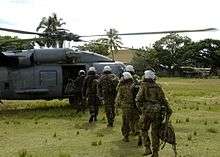
New Zealand states it maintains a "credible minimum force", although critics (including the New Zealand National Party while in opposition) maintain that the country's defence forces have fallen below this standard.[85] With a claimed area of direct strategic concern that extends from Australia to Southeast Asia to the South Pacific, and with defence expenditures that total around 1% of GDP, New Zealand necessarily places substantial reliance on co-operating with other countries, particularly Australia.
Acknowledging the need to improve its defence capabilities, the government in 2005 announced the Defence Sustainability Initiative allocating an additional NZ$4.6 billion over 10 years to modernise the country's defence equipment and infrastructure and increase its military personnel. The funding represented a 51% increase in defence spending since the Labour government took office in 1999.
New Zealand is an active participant in multilateral peacekeeping. It has taken a leading role in peace-keeping in the Solomon Islands and the neighbouring island of Bougainville. New Zealand has contributed to United Nations and other peacekeeping operations in Angola, Cambodia, Somalia, Lebanon and the former Yugoslavia. It also participated in the Multilateral Interception Force in the Persian Gulf. New Zealand has an ongoing peacekeeping commitment to East Timor, where it participated in the INTERFET, UNTAET and UMAMET missions from 1999–2002. At one point over 1,000 NZDF personnel were in East Timor. The deployment included the vessels HMNZS Canturbury, Te Kaha and Endeavour, six Iroquois helicopters, two C-130 Hercules and an infantry battalion. In response to renewed conflict in 2006 more troops were deployed as part of an international force. New Zealand has participated in 2 NATO-led coalitions; SFOR in the Former Yugoslavia (until December 2004) and an ongoing one in Afghanistan (which took over from a US-led coalition in 2006). New Zealand also participated in the European Union EUFOR operation in the former Yugoslavia from December 2004 until New Zealand ended its 15-year continuous contribution there on 30 June 2007.
As of December 2015, New Zealand has 167 personnel deployed across the globe. These deployments are to Afghanistan(8), Antarctica(8), South Korea(5), Iraq(106), Middle East(8), Sinai(26), South Sudan(3) and the United Arab Emirates(11). 209 NZDF personnel are on other deployments and exercises.
New Zealand shares training facilities, personnel exchanges, and joint exercises with the Philippines, Thailand, Indonesia, Papua New Guinea, Brunei, Tonga, and South Pacific states. It exercises with its Five Power Defence Arrangements partners, Australia, the United Kingdom, Malaysia, and Singapore. New Zealand military personnel participate in training exercises, conferences and visits as part of military diplomacy.
New Zealand is a signatory of the ANZUS treaty, a defence pact between New Zealand, Australia and the United States dating from 1951. After the 1986 anti-nuclear legislation that refused access of nuclear-powered or armed vessels to ports, the USA withdrew its obligations to New Zealand under ANZUS, and ANZUS exercises are now bilateral between Australia and the United States. Under anti-nuclear legislation, any ship must declare whether it is nuclear-propelled or carrying nuclear weapons before entering New Zealand waters. Due to the US policy at that time of "neither confirm nor deny", ship visits ceased although NZ and the USA remained "good friends".[86] Despite the Presidential Directive of 27 September 1991 that removed tactical nuclear weapons from U.S. surface ships, attack submarines, and naval aircraft,[87] ship visits have not resumed. Despite signs of rapprochement in recent years, military relationships with the US remain limited.
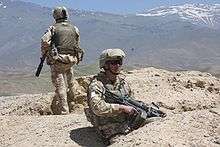
The NZDF served alongside NATO-led forces in Afghanistan in the first decade of the twenty-first century, and in 2004 the NZSAS was awarded a Presidential Unit Citation by US President George W Bush for "extraordinary heroism" in action. In 2008 US Secretary of State Condoleezza Rice during a visit to New Zealand said "New Zealand is now a friend and an ally".[88]

New Zealand is a member of the ABCA Armies standardisation programme, the naval AUSCANNZUKUS forum, the Air and Space Interoperability Council (ASIC, the former ASCC, which, among other tasks, allocates NATO reporting names) and other Western 'Five Eyes' fora for sharing signals intelligence information and achieving interoperability with like-minded armed forces, such as The Technical Cooperation Program (TTCP).
See also
- List of New Zealand military bases
- List of individual weapons of the New Zealand armed forces
- New Zealand Defence College
- Current Royal New Zealand Navy ships
- List of ships of the Royal New Zealand Navy
- Royal New Zealand Navy plans
- List of aircraft of the RNZAF and RNZN
- List of squadrons of the RNZAF
- New Zealand Cadet Forces
References
Citations
- "New Zealand Defence Act 1990". 1 September 2017. Archived from the original on 17 February 2018.
- "Table 3: Estimated residential population by five-year age group". New Zealand Ministry of Statistics. 2017.
- "Table 3: Estimated residential population by five-year age group". New Zealand Ministry of Statistics. 2017.
- "Briefing for the Incoming Minister of Defence" (PDF). 30 June 2017. Archived from the original (PDF) on 5 May 2018. Retrieved 5 May 2018.
- "Total Appropriations for Each Vote". Budget 2019. The Treasury. Retrieved 8 June 2019.
- "The World Factbook". Cia.gov. Retrieved 26 September 2018.
- "New Zealand". State.gov. Retrieved 2 November 2016.
- "Briefing for the Incoming Minister of Defence". New Zealand Defence Force. 30 June 2017. Retrieved 27 September 2018.
- Elizabeth II (28 October 1983), Letters Patent Constituting the Office of Governor-General of New Zealand, Parliamentary Counsel Office, retrieved 23 October 2018,
We do hereby constitute, order, and declare that there shall be, in and over Our Realm of New Zealand … a Governor-General and Commander-in-Chief
- Chief of Defence Force
- "Air Vice-Marshal Kevin Short is the new chief of the Defence Force". Stuff.co.nz. 23 May 2018. Retrieved 18 June 2018.
- "Chief of Defence Force Change of Command Ceremony". www.nzdf.mil.nz. New Zealand Defence Force. 29 June 2018. Retrieved 18 July 2018.
- "New Vice Chief of Defence Force Named". www.nzdf.mil.nz. New Zealand Defence Force. 9 July 2018. Retrieved 18 July 2018.
- Editorial, New Zealand Gazette and Wellington Spectator, Vol 14 issue 70, 14 August 1841, p 2
- Editorial, New Zealand Colonist and Port Nicholson Advisor, Vol 1 issue 104, 28 July 1843, p 2
- Legislative Council, Daily Southern Cross, Vol 2 issue 76, 28 September 1844
- Bay of Islands, Daily Southern Cross, Vol 2 issue 101, 22 March 1845, p 2
- Mounted Police, New Zealander, Volume 2, Issue 59, 18 July 1846, page 2
- Militia Ordinance, Daily Southern Cross, Vol 2 issue 103, 5 April 1845, p 2
- Daily Southern Cross, 19 April 1845, Page 4, Government Gazette Notices.
- District Orders, New Zealand Spectator and Cook's Strait Guardian, Volume I, Issue 34, 31 May 1845, Page 2
- "Nelson's war memorials". www.theprow.org.nz. Retrieved 25 January 2018.
- Bay of Islands, New Zealander, Volume 1, Issue 2, 14 June 1845, Page 3
- Colonel Despard's Despatch, New Zealander, Volume 1, Issue 7, 19 July 1845, Page 2
- Auckland, New Zealand Spectator and Cook's Strait Guardian, Volume II, Issue 51, 27 September 1845, Page 3
- Port Nicholson, Nelson Examiner and New Zealand Chronicle, Volume IV, Issue 188, 11 October 1845, Page 127
- Nelson Militia, Nelson Examiner and New Zealand Chronicle, Volume IV, Issue 187, 4 October 1845, Page 122
- Editorial, New Zealand Spectator and Cook's Strait Guardian, Volume II, Issue 74, 7 March 1846, Page 2
- Editorial, 'New Zealand Spectator and Cook's Strait Guardian', Volume II, Issue 75, 14 March 1846, Page 2
- Port Nicholson,'New Zealander', Volume I, Issue 49, 9 May 1846, Page 3
- Port Nicholson, 'New Zealander', Volume 2, Issue 56, 27 June 1846, Page 3
- Legislative Council, 'New Zealander', Volume 2, Issue 74, 31 October 1846, Page 2
- Military, 'New Zealander', Volume 3, Issue 119, 21 July 1847, Page 3
- Withdrawal of the troops, 'Daily Southern Cross', Volume VI, Issue 433, 22 August 1851, Page 2
- Letters to the Editor. Our defences, 'Nelson Examiner and New Zealand Chronicle', Volume XIII, Issue 639, 3 June 1854, Page 5
- Proceedings of the General Assembly, Taranaki Herald, Volume V, Issue 211, 16 August 1856, Page 2
- Proclamation, Taranaki Herald, Volume VI, Issue 288, 6 February 1858, Page 3
- Arts Of the General Assembly, Colonist, Issue 84, 10 August 1858, Page 4
- "BRITISH TROOPS IN NEW ZEALAND – Te Ara: The Encyclopedia of New Zealand". Teara.govt.nz. 22 April 2009. Retrieved 24 June 2015.
- Taranaki Volunteer Rifle Corps, Taranaki Herald, Volume VII, Issue 340, 5 February 1859, Page 3
- Auckland, Nelson Examiner and New Zealand Chronicle, Volume XVIII, Issue 71, 3 September 1859, Page 2
- Untitled, Hawke's Bay Herald, Volume 2, Issue 103, 10 September 1859, Page 2
- Wellington - split in the Ministry, Otago Daily Times, Issue 233, 18 September 1862, Page 5
- (From our own correspondent), Daily Southern Cross, Volume XIX, Issue 1782, 6 April 1863, Page 6
- Provincial Council, Hawke's Bay Herald, Volume 6, Issue 376, 11 April 1863, Page 2
- Nelson Examiner and New Zealand Chronicle, Volume XXII, Issue 37, 25 April 1863, Page 2
- Military and volunteer movements, Daily Southern Cross, Volume XIX, Issue 1869, 14 July 1863, Page 3
- The Defence Force, Wellington Independent, Volume XVII, Issue 1895, 16 July 1863, Page 2
- Military and volunteer movements, Daily Southern Cross, Volume XIX, Issue 1870, 15 July 1863, Page 3
- Taranaki Herald, Volume XII, Issue 585, 17 October 1863, Page 2
- Hawke's Bay (from our own correspondent) Napier, 17 July 1863, Daily Southern Cross, Volume XIX, Issue 1876, 22 July 1863, Page 3
- Local Intelligence, Hawke's Bay Herald, Volume 6, Issue 406, 29 July 1863, Page 2
- Local Intelligence, Wellington Independent, Volume XVIII, Issue 1897, 21 July 1863, Page 2
- Appointments, Wellington Independent, Volume XVIII, Issue 1970, 15 October 1863, Page 3
- News of the Week, Otago Witness, Issue 622, 30 October 1863, Page 5
- House of Representatives - Tuesday, 3 November 1863, Daily Southern Cross, Volume XIX, Issue 1966, 4 November 1863, Page 4
- Disbanding the Defence Force, 'Wellington Independent', Volume XIX, Issue 2121, 29 October 1864, Page 3
- Imperial v. colonial troops question, Southland Times, Volume I, Issue 74, 18 November 1864, Page 3
- Parliament of New Zealand, Daily Southern Cross, Volume XX, Issue 2298, 1 December 1864, Page 5
- On the defences of the Colony, Nelson Examiner and New Zealand Chronicle, Volume XXIV, Issue 51, 29 April 1865, Page 3
- Coastal defences, 'Colonist', Volume IX, Issue 916, 13 July 1866, Page 5
- Notice to the coast natives, Daily Southern Cross, Volume XIX, Issue 1885, 1 August 1863, Page 4
- New Zealand Gazette, Daily Southern Cross, Volume XXIII, Issue 3209, 29 October 1867, Page 4
- "1846 Constabulary Act". rnza.co.nz. Retrieved 25 January 2018.
- Taonga, New Zealand Ministry for Culture and Heritage Te Manatu. "Roberts, John Mackintosh". Retrieved 2 November 2016.
- Hare, McLintock, Alexander; Wellington., Richard Ainslie Barber, N.Z.L.A.CERT., Librarian, Army Department, Wellington.Richard Ainslie Barber, N.Z.L.A.CERT., Librarian, Army Department; Taonga, New Zealand Ministry for Culture and Heritage Te Manatu. "The Territorial Force". Retrieved 2 November 2016.
- "1941 Royal New Zealand Navy Established". Archived from the original on 17 October 2008. Retrieved 17 July 2009.
- https://www.sunlive.co.nz/news/228792-first-woman-commodore-takes-over-deputy-chief-role.html
- http://www.airforce.mil.nz/about-us/who-we-are/key-personnel/dcaf.htm
- Major General Evan G. Williams, accessed February 2020.
- Archived 25 May 2009 at the Wayback Machine
- NZSIS Annual Report 2012-2013 , retrieved on 24 October 2017
- Reports in several mainstream media outlets such as Newshub , 3 March 2017. Retrieved 24 October 2017.
- The Dominion Post, , June 13, 2017, Retrieved 24 October 2017
- Archived 11 May 2012 at the Wayback Machine
- "NZDF - soc". New Zealand Defence Force. New Zealand Defence Force. Retrieved 27 September 2016.
- "Land Component Commander". NZDF. Retrieved 1 October 2016.
- "Changes Afoot for Special Operations Command" (PDF). Army News. New Zealand Army. July 2015. p. 10. Retrieved 6 August 2015.
- "NZDF Annual Report 2015-2016" (PDF).
- "About Milestone Direct | Milestone Direct". nzdf.milestonedirect.co.nz. Retrieved 9 April 2018.
- "Milestone gets military contract - Good Returns". www.goodreturns.co.nz. Retrieved 7 April 2018.
- "2016 Defence White Paper" (PDF). NZ Ministry of Defence. NZ Ministry of Defence. 8 June 2016. p. 86. Archived from the original (PDF) on 8 June 2016. Retrieved 8 June 2016.
- Chapman, Paul New Zealand scraps air force warplanes May 9, 2011 The Telegraph Retrieved June 23, 2016
- RNZAF Skyhawks to become museum pieces April 8, 2011 Australian Aviation Retrieved June 23, 2016
- "News". National.org.nz. Archived from the original on 29 July 2013. Retrieved 24 June 2015.
- "Clark and Bush: focusing on the common ground". The Press. 19 March 2007. Archived from the original on 30 September 2007. Retrieved 6 May 2007.
- "Para 4b of Chief of Naval Operations OPNAVINST 5721.lF N5GP Release of Information on Nuclear Weapons and on Nuclear Capabilities of U.S. Forces" (PDF). Fas.org. 3 February 2006. Retrieved 5 January 2019.
- "Scoop World Coverage: Sec. Condoleezza Rice In NZ - Scoop News". Retrieved 2 November 2016.
Sources
- Rolfe, James (1999). The Armed Forces of New Zealand. Sydney, NSW: Allen & Unwin. ISBN 1-86448-800-X.
- Rolfe, James (2007). Cutting their cloth: New Zealand's defence strategy. Canberra, ACT: Australian Strategic Policy Institute. ISBN 978-1-921302-10-7.